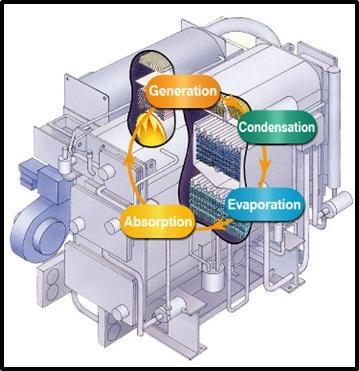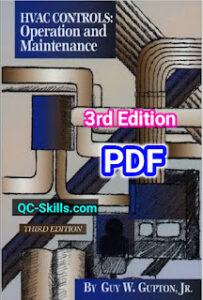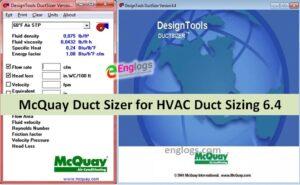Absorption chillers use a different mechanism from traditional chillers, and are powered by heat rather than using electricity, potentially resulting in significant efficiency gains. The cooling mechanism is still evaporative — a liquid transforming into a vapor — but the reliquification is different. Instead of being compressed, the vapor is absorbed into another liquid. The classic cycle here uses ammonia, which is absorbed into water.

Advantages of Absorption Chillers:-
The ideal solution for creating tri-generation enterprise. Tri generation complex – a complex allows to date as much as possible to reduce the cost of electricity, hot water, heating and cooling for the enterprise through the use of its own cogeneration power plant in conjunction with an absorption chiller.
- Long service life – within 20 years before the first major overhaul;
- Low cost of produced cold, cold is produced almost free of charge
- Reduced noise and vibration as a result of the lack of compressors with electric motors, as a consequence – quiet operation and high reliability;
- The use of refrigeration / heating units with the flame of a gas generator of direct action eliminates the boilers to be used in conventional installations. This reduces the initial cost of the system and makes absorption chillers competitive compared to conventional systems, which utilize boilers and chillers;
- Maximizing energy savings during periods of peak demand. In other words, do not consume electricity for the production of cold / heat absorption chillers do not overload the power supply enterprise, even in times of peak demand;
- There is the possibility of combining in the district steam systems with efficient refrigeration unit of double effect;
- It is possible to load balancing in conditions of maximum efficiency in the cooling mode. The device handles the critical load in the cooling mode, with minimal power consumption through the use of refrigerants with a flaming gas generator direct effect or generator with steam heating;
- It allows the use of emergency generators at the power, as energy consumption in absorption chillers is minimal when compared with electric refrigeration units;
- Security for the ozone layer does not contain refrigerants that deplete the ozone. Cooling is carried out without the use of refrigerants containing chlorine;
- Minimizes the overall impact on the environment as the consumption of electricity is reduced and the gas causing the greenhouse effect and global warming as a consequence.
Disadvantages of Absorption Chillers:-
- Initial capital cost: Though the running cost of the absorption refrigeration system is much lesser than the vapor compression system, its initial capital cost is much higher.
- Corrosive nature of lithium bromide: In the lithium bromide absorption refrigeration system, lithium bromide is corrosive in nature, which reduces the overall life of the system. In case of the ammonia system, ammonia is corrosive to copper. In the vapor compression system copper is used with the halo carbon refrigerants and they are quite safe thus ensuring long life of the refrigeration system. As such the vapor compression system with reciprocating or centrifugal compressor has longer life than the lithium bromide absorption refrigeration system.
- Low working pressures: The working pressures of the absorption refrigeration cycle are very low. In case of the lithium bromide system these pressures are so low that even the expansion valve is not required since the drop in pressure of the refrigerant due to its flow is good enough to produce its expansion. Due to this the refrigeration system should be sealed thoroughly so that no atmospheric gases would enter the refrigeration system.As such the system of the compression refrigeration should also be packed tightly, but this is to prevent the leakage of the refrigerant to the atmosphere.
- Coefficient of Performance (COP): The coefficient of performance of the absorption refrigeration systems is very low compared to the vapor compression systems. For instance, the COP of the two stage lithium bromide system is about 1.1, while that of the vapor compression system used for the air conditioning applications it is about 4 to 5.Thus the absorption refrigeration system becomes competitive only if the ratio of the electricity to fuel (oil, gas or coal used to generate the steam in the boiler) becomes more than four. If this ratio is lesser there are chances that excess fuel would be required to generate the steam. However, if there is excess steam in the industry, this ratio may not be given importance.
- Higher heat rejection: In the absorption refrigeration heat has to be rejected from number of parts like condenser, absorber, analyzer, rectifier etc. thus heat rejection factor for absorption refrigeration system is high and it can be around 2.5. In the compression refrigeration system the heat is given up only from the condenser, so it heat rejection factor is small, which is about 1.2. Thus the cooling tower and pump capacities for pumping the cooling water have to be higher in case of the absorption refrigeration system, which leads to increase in the running cost of the system.

When to use an Absorption Chiller:-
1 Consider using an absorption chiller when your electricity costs are high, but your fuel costs are low. This differential usually needs to be pretty large, as we’ll show in our example at the end.
2 Consider using an absorption chiller when you have adequate low grade waste steam or hot water available—especially during the cooling season. The key word here is “waste” heat. If you’re producing more steam than you would otherwise use just for the purpose of supplying the chiller, it’s not waste steam. You’re paying for the fuel to make it. Note that we have seen people fool themselves or be bamboozled by vendors because they did not understand this very key difference.
3 Consider using an absorption chiller if you have adequate capacity on your low pressure heating systems to produce excess heat during the cooling season. Make sure that items 1 or 2 also apply.



